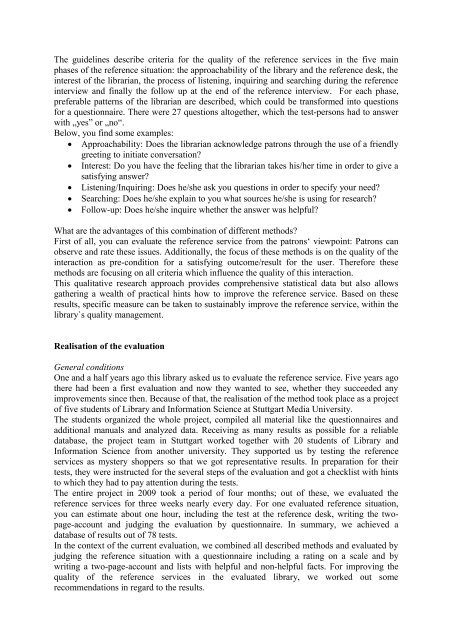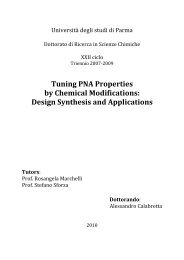Mystery shoppers test the reference service in a public library
Mystery shoppers test the reference service in a public library
Mystery shoppers test the reference service in a public library
Create successful ePaper yourself
Turn your PDF publications into a flip-book with our unique Google optimized e-Paper software.
The guidel<strong>in</strong>es describe criteria for <strong>the</strong> quality of <strong>the</strong> <strong>reference</strong> <strong>service</strong>s <strong>in</strong> <strong>the</strong> five ma<strong>in</strong><br />
phases of <strong>the</strong> <strong>reference</strong> situation: <strong>the</strong> approachability of <strong>the</strong> <strong>library</strong> and <strong>the</strong> <strong>reference</strong> desk, <strong>the</strong><br />
<strong>in</strong>terest of <strong>the</strong> librarian, <strong>the</strong> process of listen<strong>in</strong>g, <strong>in</strong>quir<strong>in</strong>g and search<strong>in</strong>g dur<strong>in</strong>g <strong>the</strong> <strong>reference</strong><br />
<strong>in</strong>terview and f<strong>in</strong>ally <strong>the</strong> follow up at <strong>the</strong> end of <strong>the</strong> <strong>reference</strong> <strong>in</strong>terview. For each phase,<br />
preferable patterns of <strong>the</strong> librarian are described, which could be transformed <strong>in</strong>to questions<br />
for a questionnaire. There were 27 questions altoge<strong>the</strong>r, which <strong>the</strong> <strong>test</strong>-persons had to answer<br />
with „yes” or „no“.<br />
Below, you f<strong>in</strong>d some examples:<br />
� Approachability: Does <strong>the</strong> librarian acknowledge patrons through <strong>the</strong> use of a friendly<br />
greet<strong>in</strong>g to <strong>in</strong>itiate conversation?<br />
� Interest: Do you have <strong>the</strong> feel<strong>in</strong>g that <strong>the</strong> librarian takes his/her time <strong>in</strong> order to give a<br />
satisfy<strong>in</strong>g answer?<br />
� Listen<strong>in</strong>g/Inquir<strong>in</strong>g: Does he/she ask you questions <strong>in</strong> order to specify your need?<br />
� Search<strong>in</strong>g: Does he/she expla<strong>in</strong> to you what sources he/she is us<strong>in</strong>g for research?<br />
� Follow-up: Does he/she <strong>in</strong>quire whe<strong>the</strong>r <strong>the</strong> answer was helpful?<br />
What are <strong>the</strong> advantages of this comb<strong>in</strong>ation of different methods?<br />
First of all, you can evaluate <strong>the</strong> <strong>reference</strong> <strong>service</strong> from <strong>the</strong> patrons‘ viewpo<strong>in</strong>t: Patrons can<br />
observe and rate <strong>the</strong>se issues. Additionally, <strong>the</strong> focus of <strong>the</strong>se methods is on <strong>the</strong> quality of <strong>the</strong><br />
<strong>in</strong>teraction as pre-condition for a satisfy<strong>in</strong>g outcome/result for <strong>the</strong> user. Therefore <strong>the</strong>se<br />
methods are focus<strong>in</strong>g on all criteria which <strong>in</strong>fluence <strong>the</strong> quality of this <strong>in</strong>teraction.<br />
This qualitative research approach provides comprehensive statistical data but also allows<br />
ga<strong>the</strong>r<strong>in</strong>g a wealth of practical h<strong>in</strong>ts how to improve <strong>the</strong> <strong>reference</strong> <strong>service</strong>. Based on <strong>the</strong>se<br />
results, specific measure can be taken to susta<strong>in</strong>ably improve <strong>the</strong> <strong>reference</strong> <strong>service</strong>, with<strong>in</strong> <strong>the</strong><br />
<strong>library</strong>`s quality management.<br />
Realisation of <strong>the</strong> evaluation<br />
General conditions<br />
One and a half years ago this <strong>library</strong> asked us to evaluate <strong>the</strong> <strong>reference</strong> <strong>service</strong>. Five years ago<br />
<strong>the</strong>re had been a first evaluation and now <strong>the</strong>y wanted to see, whe<strong>the</strong>r <strong>the</strong>y succeeded any<br />
improvements s<strong>in</strong>ce <strong>the</strong>n. Because of that, <strong>the</strong> realisation of <strong>the</strong> method took place as a project<br />
of five students of Library and Information Science at Stuttgart Media University.<br />
The students organized <strong>the</strong> whole project, compiled all material like <strong>the</strong> questionnaires and<br />
additional manuals and analyzed data. Receiv<strong>in</strong>g as many results as possible for a reliable<br />
database, <strong>the</strong> project team <strong>in</strong> Stuttgart worked toge<strong>the</strong>r with 20 students of Library and<br />
Information Science from ano<strong>the</strong>r university. They supported us by <strong>test</strong><strong>in</strong>g <strong>the</strong> <strong>reference</strong><br />
<strong>service</strong>s as mystery <strong>shoppers</strong> so that we got representative results. In preparation for <strong>the</strong>ir<br />
<strong>test</strong>s, <strong>the</strong>y were <strong>in</strong>structed for <strong>the</strong> several steps of <strong>the</strong> evaluation and got a checklist with h<strong>in</strong>ts<br />
to which <strong>the</strong>y had to pay attention dur<strong>in</strong>g <strong>the</strong> <strong>test</strong>s.<br />
The entire project <strong>in</strong> 2009 took a period of four months; out of <strong>the</strong>se, we evaluated <strong>the</strong><br />
<strong>reference</strong> <strong>service</strong>s for three weeks nearly every day. For one evaluated <strong>reference</strong> situation,<br />
you can estimate about one hour, <strong>in</strong>clud<strong>in</strong>g <strong>the</strong> <strong>test</strong> at <strong>the</strong> <strong>reference</strong> desk, writ<strong>in</strong>g <strong>the</strong> twopage-account<br />
and judg<strong>in</strong>g <strong>the</strong> evaluation by questionnaire. In summary, we achieved a<br />
database of results out of 78 <strong>test</strong>s.<br />
In <strong>the</strong> context of <strong>the</strong> current evaluation, we comb<strong>in</strong>ed all described methods and evaluated by<br />
judg<strong>in</strong>g <strong>the</strong> <strong>reference</strong> situation with a questionnaire <strong>in</strong>clud<strong>in</strong>g a rat<strong>in</strong>g on a scale and by<br />
writ<strong>in</strong>g a two-page-account and lists with helpful and non-helpful facts. For improv<strong>in</strong>g <strong>the</strong><br />
quality of <strong>the</strong> <strong>reference</strong> <strong>service</strong>s <strong>in</strong> <strong>the</strong> evaluated <strong>library</strong>, we worked out some<br />
recommendations <strong>in</strong> regard to <strong>the</strong> results.

















